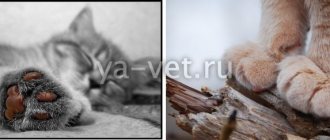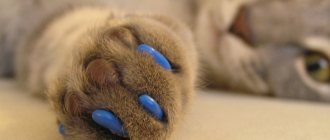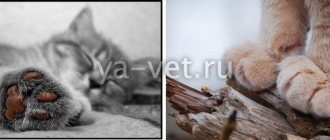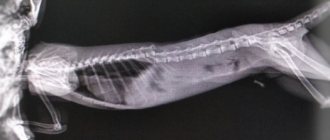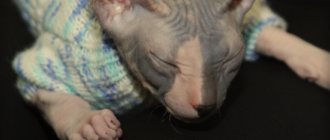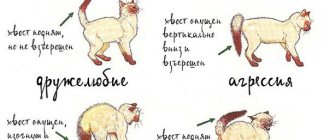Every cat lover knows firsthand what ties on furniture are. Cats love to sharpen their claws on everything they like: furniture, clothes, curtains, carpets, etc. They do this not “out of harm.” Sharpening claws is a natural need of an animal. Of course, you can simply trim your pet’s nails, but animals are not happy with this procedure. And the owners themselves do not always like this painstaking and dangerous task.
- 2 Benefits and harms of anti-scratch products for cats
- 3 How to choose anti-scratch products for cats of different ages
- 4 Rules for using anti-scratch pads
4.1 When not to cap cats’ claws
- 4.2 How to glue cat claw caps
- 6.1 Video: anti-scratch in action
What are silicone claw pads (anti-scratch)
Anti-scratch pads are cap-shaped covers for animal claws. The caps are made of soft, flexible silicone. The linings are also called “soft claws”. They are placed over cats' clipped claws to protect them from scratching.
anti-scratch is a device for protection against scratching
Anti-scratch pads were invented by veterinarian Toby Wexler (USA). This discovery became an alternative to onychectomy (declaw removal), as painful removal was considered the most inhumane way to protect against scratching. In civilized countries, onychectomy is prohibited, so anti-scratch treatments quickly became popular throughout the world. They come in different sizes, so they are suitable for cats aged four months and older. In addition, caps are now sold in different colors. However, anti-scratch pads are not just a fashionable device; sometimes purchasing such pads is vital. It is recommended to purchase claw pads in the following cases:
- if the animal is aggressive and rushes at guests;
- if the cat is overly playful and therefore violently attacks family members;
- if the cat is jealous and cannot come to terms with the appearance of another pet in the house (trying to “revenge” it);
- if there are small children in the house;
- if your pet has health problems (for example, with atopic dermatitis, the cat itches, scratching the skin until it bleeds).
Alternative
In order for everything in the house to remain in its original form, you should simply wean the cat from sharpening its claws on household objects. To do this, you can purchase a scratching post or make one yourself, building a whole play complex for your beloved pet. The main thing is not to put it off for a long time - it is very difficult to retrain an animal that is already accustomed to sharpening its claws on a soft sofa or a wooden chair leg. In addition, there are special silicone claw covers for animals that refuse to be trained.
The only thing to remember in this situation is that the pads need to be changed monthly.
The best way is to trim the tips of your nails. A more gentle method than surgery is to trim the tips of the claws with special tweezers. Pet owners who are inexperienced in this procedure should be extremely careful. It is preferable to contact a veterinarian so that he can show you how far the claws can be cut. After all, they contain blood vessels, which during the process of circumcision can be damaged and cause in the poor animal not only fear of such a procedure, but bleeding and inflammatory processes.
The benefits and harms of anti-scratch products for cats
anti-scratch products can be harmful to your pet's health
The benefits of anti-scratch pads are obvious. A cat wearing such a “manicure” will not be able to harm either things or children. Moreover, the animal will not be able to harm itself.
Every cat breeder has seen how cats itch. Some animals do this with particular frenzy. In this case, the pet can scratch its skin until it bleeds (or even tear its skin). Because of this, wounds are formed, which itch even more as they heal. They can also become infected.
In addition, some “advanced” cat owners try to purchase all kinds of devices for their pets. Instead of gray (yellowish, sometimes ugly) claws, the cat's paws will have beautiful "soft claws." But in addition to benefits, anti-scratch products can also cause harm. The pad may grow into the pad of the paw. But claws can grow in without a cap, so this is only indirect harm. You need to examine your pet's paw more often. Typically, ingrowths occur when they are not applied correctly. According to the rules, the cap should not fit to the claw all the way to the base, but with an indentation of several millimeters. You should also not put caps on untrimmed claws.
In addition, the cat can get injured (and even pull out a claw) if the pad gets stuck in something. To prevent this from happening, you need to monitor what the animal comes into contact with. For example, the cap can get stuck in grilles or cracks, or get caught in blinds or long carpet fibers. After all, a cat walking outside can get stuck in a tree or get caught on a nail. Control is especially important at first, until the cat adapts to the anti-scratch treatment.
Consequences of the operation
The consequences of the operation may include the following conditions:
- Severe blood loss with serious complications including death
- Loss of coordination due to the need to rely on the pads of the paws rather than on the toes
- Deterioration of gait and subsequent atrophy of the muscles of the limbs and back
- Regeneration of the claw and its ingrowth into the soft tissues of the foot, which leads to repeated surgery
- Long and painful healing process
Given the many risks and unintended consequences, Operation Soft Paws, as onychectomy is commonly called, is drawing protest from animal lovers. The European Convention protecting animal rights has banned onychectomy in many European countries. And even in those countries where this operation is permitted, such as in Russia, veterinarians are opposed to onychectomy.
After declawing, cats may develop arthritis due to the emphasis placed on the pads of their feet when walking. The muscles of the paws and back atrophy, coordination of movements is impaired. A cat that has experienced stress due to this inhumane operation feels completely defenseless, its character deteriorates, and it increasingly uses its last weapon of defense - its teeth.
How to choose anti-scratch products for cats of different ages
Anti-scratch pads can be used from 4 months of age
Depending on the age of the animal, you need to choose the size of the pads. To do this, you need to have an idea of the system of their sizes:
- tiny (XS) - for kittens from 4 months;
- small (S) - for cats whose weight is 2.5–4 kg;
- medium (M) - for cats from 4 to 7 kg;
- large (L) - for large breeds of cats (from 8 kg and above).
If the issue with the size of the pads is resolved, you need to pay attention to other nuances. As a rule, the caps are packaged in a transparent bag (the bag may be inside the box). Review the product. The linings must be smooth, without flaws or damage. The packaging must be undamaged. Pay attention to the instructions and labels on the packaging. The manufacturer should not cause you any doubts.
When faced with a choice between an expensive, high-quality item and its budget option, the latter often wins. However, anti-scratch products are not an expensive purchase in themselves. The packaging lasts a long time, which means you can buy the more expensive option.
Disadvantages of overlays
They claim that the latter do not cause cats any inconvenience: supposedly, whiskered cats with anti-scratch protection just as easily jump, run and conquer peaks.
In fact, with pads, all the cat’s usual actions and reflexes are greatly complicated: without sharp claws, the pet cannot climb high surfaces and slow down when turning during games. It is not surprising that cats with “soft claws” are more likely to fall (including from heights) and get injured.
For such an animal, basic hygiene procedures are difficult: it is inconvenient for him to itch, clean his ears and wash himself.
The claw, supplemented with a protective case (even the softest one), does not retract into the paw, which means the cat is forced to walk with its toes spread out.
Important! Odd foot positioning changes a cat's gait, causing discomfort and sometimes pain. In addition, any jump down can result in a fracture of the protruding fingers.
Another danger of protective caps is the glue used to fix them: it can provoke severe allergies . In addition, cats with “soft claws” are more susceptible to a variety of dermatitis, which develops due to sweat and oil that gets trapped under the caps and decomposes there.
And the last unpleasant property of nail pads is that, depending on their material, they creak, knock or click when the cat is actively moving (walking on the floor, rummaging in the tray or playing). Not every person can tolerate such sounds without internal tension.
Rules for using anti-scratch pads
Before you start working with anti-scratch products, you need to carefully study the instructions
The package can include up to 40 pads, glue and instructions. Before starting work, you should carefully study the operating instructions. If you stick the caps only on the front legs, the package will be enough for 4 times. The pads stay on the claws for up to 8 weeks. If the cat does not take them off earlier, and you put them on strictly according to the instructions, then the packaging will last for several months (up to six months) . If you make a mistake with the size, the caps can be changed at the seller or trimmed. At the time of fitting it will become clear whether there is such a need.
When not to cap cats' claws
Anti-scratch guards are intended for domestic cats. That is, for those animals that do not end up on the street. Firstly, the owner cannot always keep track of the cat if it goes out. And there are many dangers on the street (for example, claw injury). Secondly, the animal must be able to climb to some height (if necessary).
Anti-scratch guards should also not be placed on the claws of pets prone to allergies (the cat may not tolerate glue). The original packaging comes with good quality glue, so the risk of allergies is low. But no one can guarantee the quality of the glue that comes with cheap fakes.
It is not advisable to stick caps on the claws of a sick cat
If your pet is sick, it is better not to irritate him with innovations. A weakened animal may not resist, but due to an unexpected “manicure” the cat may become stressed. This may make the condition worse.
How to glue cat claw caps
Before gluing the pads, you need to organize a fitting (without glue) on already trimmed nails. There is no need to trim the nails completely. It is enough to cut off the sharp corner of the claw and also treat it with a nail file on all sides. After this, the claws are degreased, for example, with alcohol (you can use acetone, but the cat may not like the pungent smell). This is necessary for better adhesion to the glue. The cap should not slip off, and its edges should be at a distance of 3–5 millimeters from the base of the claw. If this indentation is not a balloon, then the overlay can be shortened using scissors. After trying on all the caps, you can begin gluing. You need to work with glue very carefully. If there is too much of it, a drop of glue will fall on the cat's fingers, and it will hurt the cat when it moves. You can follow the following plan:
- Calm the cat (you can pet it or give it a treat) so that it is not afraid.
- Place a small amount of glue inside the cap.
- Take the cap in your right hand, and lightly press on the paw with your left so that the animal releases its claws.
- Place the cap on the desired claw (without releasing your left hand).
- Make sure that the glue does not get on the skin near the claw.
- Wait a while (5 minutes) until the glue dries.
If there is still a lot of glue, you need to wipe off the excess with a napkin. This must be done quickly so that the glue does not have time to dry. After gluing all the caps, the cat will try to rip them off, so you need to distract the cat (with food or a toy) for some time after the procedure.
What to do instead of surgery
Veterinarians and zoologists have long understood the problem and found solutions that can help avoid surgery and keep the interior intact. To protect yourself from scratching, you can use safe methods designed for cats:
- Trimming the dead sharp tips of the claws. This will reduce the need to regularly sharpen the claws on all accessible surfaces.
- Silicone stickers on claws. They are attached with special glue like false nails. Protect the owner from injury. But the animal does not lose the ability to slow down in a jump and secrete a secret to mark its territory.
- Training to use a scratching post. Sometimes a cat just needs to sharpen its claws for peace of mind. Such is the nature of a cat. Just show your pet where it can be done: the same way you trained it to use the tray.
All methods are painless and harmless to the cat and do not cause discomfort. If you spend a little more time on your animal, you can easily do without a mutilating and dangerous operation.
Veterinary doctors do not perform onychectomy or soft paw surgery. But if your cat scratches, contact us for a consultation. We will find the cause of the problem and help you fix it.
How often should you change cat claw attachments?
It is possible that from time to time the cat will remove the anti-scratch protection itself.
If your four-legged friend sometimes tears off (loses) the pads, they can be re-glued. You cannot use the old cap; you will need to glue a new cover each time. Moreover, you don’t have to wait until all the anti-scratch pads fall off; you can add them one at a time.
Some who have never tried it before buy several sets of anti-scratch products in different colors. For example, in bags of 10 or 20 pieces. Using the entire set at one time, for “correction” you will have to open another bag. The next time you completely replace all the pads, one cap may not be enough. Therefore, it is more convenient to buy anti-scratch pads with a large number of pads of the same color, for example, 40 or 60 pieces. Or buy several packages of different colors and mix. Such methods are suitable for those people who already have an adult cat (the size of the claw will not change).
Of course, anti-scratch pads do not stick forever. The natural claw must sometimes be released, but tearing off a tightly fitting pad is painful for the animal. Therefore, you can wait until your pet's claw is updated. As the claw tissue is renewed, old cells will die off. Thus, the cap will easily come off along with the dead layer of the claw. This can happen about a month after gluing. In younger cats, this period may be shorter (about 3 weeks), but this is rare. A properly glued cap can last up to 8 weeks.
Veterinarian consultation
Many people are afraid that their cat’s claws will itch under the pads.
This is not true, since the keratinized epithelium, which is the claws, cannot itch.
As an example, women’s nails under silicone or acrylic coatings do not itch.
Worries about the fact that the caps will need to be removed over time and that it will hurt the cat are also considered unfounded.
The overlays usually fall off on their own along with the regrown keratinized top layer of the claw.
Don't worry about your gait either.
Even if in the first hours the animal walks strangely and carefully, as if feeling the surface and raising its paws high, this will pass very quickly.
There is also no need to worry that your cat will not be able to hide her claws: properly applied covers will not prevent this habit.
People often ask what will happen if a cat bites off and swallows an anti-scratch.
Nothing bad will happen: the smooth cap, made of non-toxic silicone, will easily pass through the digestive tract and will not cause any harm.
Reviews from owners and veterinarians
Sometimes cat owners devote so much time and effort to caring for their pet that it becomes difficult not to share their experience with others
There are many online forums devoted to topics about cats and cats. Cat breeders share their victories and disappointments, experiences and knowledge. And sometimes inexperienced pet owners just need advice. Few owners know about anti-scratches. Those who have already tried to use them are either satisfied with the device (and praise it) or disappointed (and criticize it). Some people who tried anti-scratch products got completely unexpected results.
I glued these to my cat, they are great. What’s funny is that I haven’t even run out of one box, but I stopped gluing them to him, I just continue to cut them, because he’s used to his nails not being scratched and has stopped even tearing up rugs. But I glued them to him from a young age. When you glue, make sure that the glue with the cap does not stick to the finger, otherwise the nail will grow and it will hurt the cat.
Forum user
https://m.woman.ru/home/animal/thread/4363561/https://m.woman.ru/home/animal/thread/4363561/
It often happens that after improper use unpleasant consequences occur. And the point here is not in the shape of the caps, or even in the quality of the glue. It’s just that every new item always evokes many different emotions. And here it’s up to you to decide whether to use it or not.
These anti-scratches are not needed, I was convinced from my own experience. I bought them for my cat, now I am suffering both myself and the cat. She took off all these caps, I didn’t re-sculpt them so as not to torture the animal, but one of her caps couldn’t be removed, and the nail festered. Today I wanted to take her to the vet, but Sunday is a day off, and in the evening I’m going on a business trip until Friday, how will my cat be here without me.
tory11, forum visitor
https://www.zoovet.ru/forum/?items=20&page=2&tem=307273&tid=18
Feedback from pet owners
Vita Trushechkina
But I no longer doubt it. I already decided, today, after the cats went crazy, ran around like crazy and scratched our 9 month old daughter who was sitting playing on the floor. I'm not even talking about how scared she was. And yesterday I saw how one of the cats wanted to hit my daughter, but saw me and ran away. So I won't wait for them to claw her eyes out. I love our cats, but the child and his safety are more important.
Svetlana Skibenko
I'm sorry, but why are we talking only about sofas? Let's talk about the hostess's health! My cat is very affectionate and peaceful, he has been in our family since two months and has seen only tenderness - he is our favorite. But sometimes he has attacks of aggression or fear (for example, he was afraid of a working food processor) - he attacks me, his mistress. He has already repeatedly torn my legs to pieces, a couple of times even the ambulance took me away. The doctors advised me to get rid of the cat, but, again, I love him very much and don’t want to part with him. But I am still constantly afraid of his attacks. My legs are covered in terrible scars and in the summer I can’t even go to the beach! Moreover, this threatens blood poisoning. So what should I do - sacrifice the cat or is it better to use his claws?!
Jennifer
We declawed our cat. And it was a damn good decision. While all the wallpaper in our house was torn, shreds of carpets flew in all directions, etc. I endured it, trimmed the cat’s claws, ran after him with a scratching post, and so on. He sneezed on me and all my efforts. But when he with his claws jumped onto the hanger where my expensive leather jacket from Italy and my husband’s equally expensive sheepskin coat were hanging…. and, clinging to the jacket with one paw and the sheepskin coat with the other, he slid down, tearing shreds out of our clothes - this was the last straw. He was given general anesthesia and only the claws on his front paws were carefully removed. A week later he was jumping around like a saiga.
